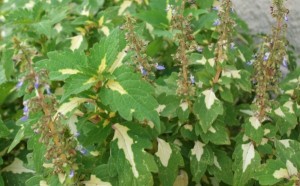The other day, a guest on one of NPR’s talk shows referred to ‘withering weather.’ Indeed, those words absolutely describe the way my garden and the plants in it look. The withered part also describes how I feel in the sixth week with no rain.
Blooms are definitely down because of the lack of rain. In the shade garden, where I’ve done a bit of supplemental watering, the Hostas are not scorched and ‘Annabelle’ (Hydrangea arborescenes) has shot up a fresh mophead.
Before I left last week for the Garden Writers Association’s symposium in Dallas, I moved all the perennials I’ve been holding in pots to the shadier side of the garden and cut them back if they looked bad. I somehow overlooked the six pots of carex (Carex conica ‘Marginata,’ ‘Snowline’ or ‘Hime Kansugi’), which remained near the edge of the blacktop driveway. A couple of them look a little brown.
The carex and the other perennials have taken a lot of abuse because they’ve spent the summer in pots rather than in the ground. Or course, I’d hope to have them grounded before I left, but that just didn’t happen. Now, I feel like I need to wait until we get a long, slow, soaking rain before planting them. Maybe it will come tonight, when the forecasters give us a 60 percent chance.
In one larger pot in the holdover group are three ‘T Rex’ sedum, sent last spring by Walters Gardens. Even with benign neglect, it has blossomed into a beautiful plant with the same pollinating insect-attracting characteristics that make sedum a must have in the garden.
In the insect-attracting category is Caryopteris, which I like because of its late-season bug-drawing flower and this woody plant’s aromatic asset.
The same with Russian sage (Perovskia), which also has done well in the hot, dry weather. Both of these plants also have winter interest as they silver out.
Like Carol of May Dreams Gardens, host of Garden Bloggers’ Bloom Day, my rare goldenrod (Solidago shortii) is blooming amidst the Igloo series’ Frosty Morn Chrysanthemum. A short distance away is the Lespedeza that showers its spot in the garden with pink flowers.
In its third year in the wrong spot stands a 4-foot tall coreopsis (Coreopsis tripteris) still looks decent. I really must move it though.
In the annual category, I’ve been amazed and pleased by the size of ColorBlaze Alligator Tears coleus (Solenostemon scutellarioides), a Proven Winners introduction sent to me this spring. With a nicely rounded shape, one of these nicely fills an 18-inch diameter pot. Another attribute is its slowness to bloom, although personally, I don’t mind the blue spikes of coleus.
The coleus in Texas were amazing, too, thriving in the even hotter and more humid climate of Dallas. Caladium, a tender bulb, also was heavily planted in many gardens, including the Dallas Arboretum, in hot sun. I might have to give these newer sun-tolerant tropicals a niche in my garden, too.
Something that only has to be planted once in the landscape is sweet autum clematis (Clematis ternifolia). Although beautiful and wonderfully fragrant, it can take over as well as self sow all over everywhere. The best control is to pull or cut back as much as you can before the seed heads form. Of course, the seed heads are one of the plants attributes, as are most clematis.
The blooms of asters ‘Alma Potschke’ (Symphyotrichum novae-angliae) and ‘Raydon’s Favorite’ (Symphyotrichum oblongifolius) and the red berries on the native dogwoods (Cornus florida) signal change is in the air.




My Igloo series’ Frosty Morn Chrysanthemum is not yet blooming, but I hope it is blooming soon, And I did not get that rain last night, but suspect it was hit or miss throughout the city so maybe you got some?